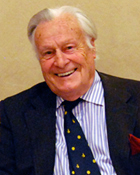Geoffrey Wellum DFC 1921 – 2018
Geoffrey was educated at a Public School through his youthful years in the Midlands. At the age of 17 he was the captain of the 2nd X1 School Cricket Team. He knew that in his final year he was to be elevated to the First Team and possibly as Captain. He had watched and dreamed of becoming a Fighter Pilot after leaving School. Within his last year he wrote to the Air Ministry stating his case. Six months later his Headmaster called him to his Office and told him that he had received a letter from the Air Ministry asking the Headmaster to verify all that Geoffrey had stated and checking if he would provide a personal reference.
The next weekend Geoffrey went home to see his parents as he understood that his father had received a similar letter. This was in 1938 and the war clouds were gathering across Europe. His mother was against giving permission for this 17 year old to join the RAF but his father said it would make a man of him and he signed and returned a letter giving his approval. Soon afterwards Geoffrey received a letter asking him to attend an interview at Adastral House where the Air Ministry was located. On arrival in March 1939 he was interviewed by three Officers and found that he was one of over 20 applicants from around the country. He was asked more about Cricket than about flying but he withstood his disappointment and answered their questions truthfully. In the end he was congratulated and passed on to another Office which proved to be a medical room where he was poked and prodded in all directions. He was there for a couple of hours. He was physically fit because of the amount of sport that he was involved in at school. Finally he was asked questions about his mathematical ability and geography.
He went back to school very jubilant and settled down to his last six months as the Cricket Captain. His two close friends were both aiming for Oxford but nothing would change his mind regarding the RAF. He was nearly 18 when he received instructions to report to a Flying Training School near Leicester. When he arrived he was astounded to see so many Tiger Moth aircraft, literally dozens of them. He met his instructor and immediately flew in the front seat with the instructor behind. The instructor threw the plane around the sky intending to see if Geoffrey’s stomach had the strength to withstand being upside down and inside out.
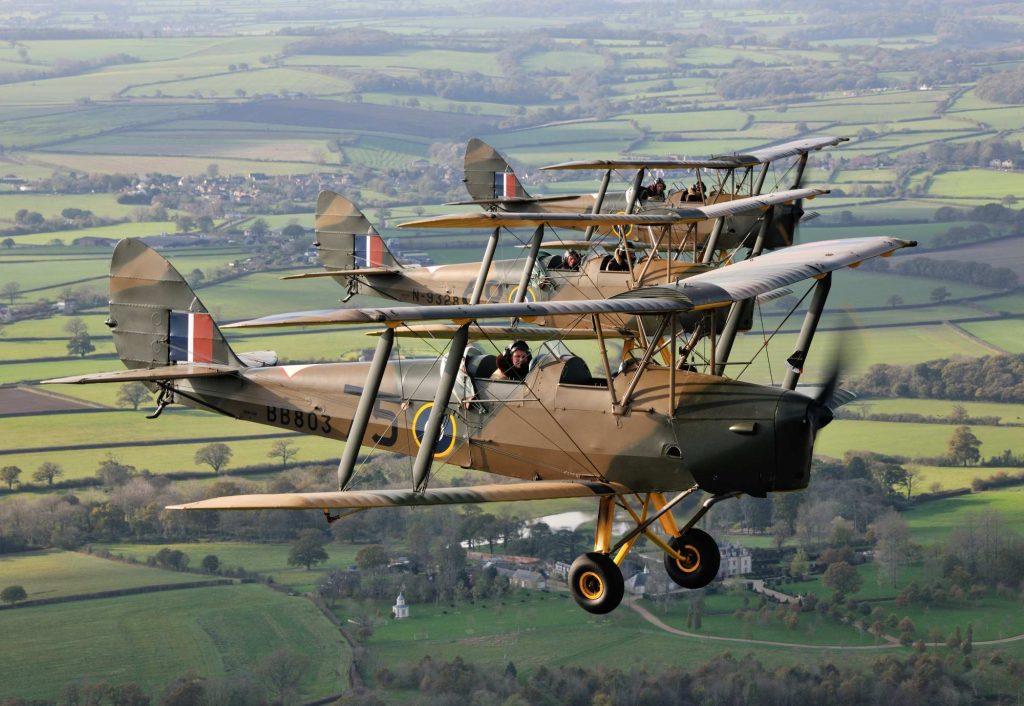
He was allowed to control the plane in straight and level flight, aiming for nominated clouds ahead. Then came Take Offs, Spinning and Stalling before he could relax. In spite of the pressure he thoroughly enjoyed his new life during the next few months. Until he came up to a high standard he wasn’t allowed to fly on his own but always with his instructor. In fact he found it hard to fly straight. The wind at altitude was often strong enough to fight against his control.
Then came September 1939 and Chamberlain’s radio message to Britain that we were at War with Germany. That changed everything. The students were given pickaxes and told to guard the planes with their lives as if the Germans were going to attack the Tiger Moths, single engine bi-planes that were no risk to anyone. Some students were suspended for not reaching the set of high standards required. Geoffrey had a Flying Test and just scraped through. He went to a local Pub for the first time and had a pint of Bitter with his five best friends. At this stage his Uniform arrived but he was still not accepted as an RAF Officer. He had a long way to go yet. He and his friends were sent to RAF Little Rissington to convert into the American Harvard Trainer. This plane had a retractable undercarriage and many more controls. After a training flight he landed only to find one of his friends, Nick, had not returned. He had simply disappeared on a Solo Training Flight. Two days later wreckage of the Harvard was found well North of where Nick should have been. He was still inside the wreckage. He had been 70 miles off course when the Harvard stalled.
As winter approached the Students were moved to Kidlington, Oxford and given further training. On Geoff’s final cross country test he landed at the wrong aerodrome but he managed to rectify things by quickly flying on to the next one. His next tuition was on Night Flying. There was no point in looking out of the front cockpit because he could see nothing at all. Only his instruments were illuminated. After 3 dual night flights the tutor jumped out and left Geoffrey on his own. “complete three satisfactory circuits on a touch-and-go principle and you will pass”. He took off, climbed to around 1,000ft, then flew downwind, crosswind and then finals in the Harvard and passed the test. Now only three remained alive out of the five who began the course and had been drinking together. Solo flights had claimed two lives.
Geoff was given the job of Night Duty in the Control Tower and he had watched his friend climb in the dark, following his tail lights which began to sink instead of climb higher. The lights should have continued straight on but instead they moved too far to starboard until eventually there was an explosion as the Harvard hit the ground. The very next day Geoff took his Final Test including the frightening Engine Failure which requires an Emergency Landing. He was in luck because there was a satellite aerodrome nearby and he landed there.
His C.O. told Geoff to sew on his Wings Badge but somehow his batman had beaten him to it and fitted the coveted Wings onto his breast pocket. What a day ! Immediately the young pilots were posted to existing squadrons around the country. His was 92 Squadron but they had moved and at first he couldn’t find them. At last he found them at Northolt with Spitfires. On arrival he was asked “how many hours have you flown in Spitfires”. “I’ve never even seen one, Sir” he replied, “but I have 168 hours on Harvards”. At Northolt there were no training facilities and Spitfires had only one seat so there was no room for a Tutor anyway.
Because of the desperate situation 92 Squadron was moved yet again, this time to Hornchurch, then Duxford. Geoff was no use to the Squadron because he didn’t know how to fly a Spitfire. He experienced severe Fear at that time followed by Mental Strain. Four of 92’s pilots were lost over Dunkirk and every able bodied man just had to fly. Geoff was given a Spitfire Manual and told to study it intensely. His C.O. gave Geoff the oldest Spitfire that they had and told him to go Solo right away without tuition. He was not yet 19 years old and frightened of “bending” the machine. “Learn as you fly” was the watchword. He managed to take-off in the old Spitfire and flew it above Hornchurch to get used to it. In fact the Spitfire trained him, it was such a good aircraft and he soon became besotted with his new aircraft. He took every opportunity to build up his number of flying hours until he became proficient. Then he was allowed to accompany the rest of 92 Squadron on patrol over South Wales and Bristol. He thought that it was a magnificent machine. The hardest part was to land the Spitfire without damaging it.
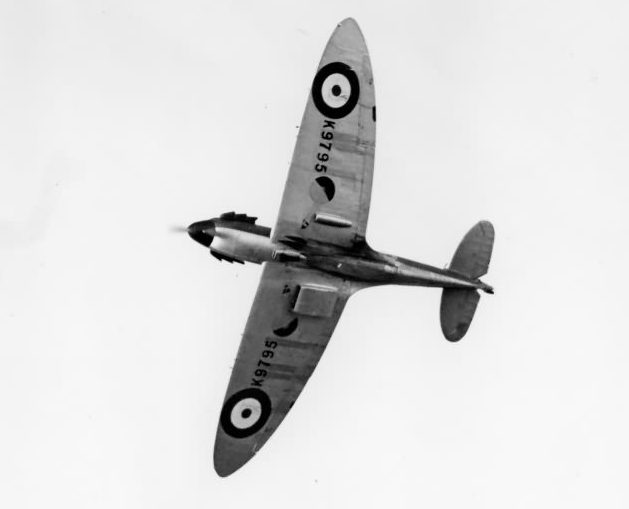
After his first night patrol in the Spitfire he got back to base and came in to land but his approach was much too early and he crashed his wing into the Landing lights. Spitfires were so precious that he was now in serious trouble and he was grounded by the C.O. Half of the Spitfires wing was missing and when his ground crew saw the machine, they were dismayed. His private fears now re-appeared and his confidence was gone. 92 Squadron shot down 4 enemy planes. Geoff’s ground crew managed to fit a new wing to his aircraft and he was encouraged to fly again. After a Test Flight Geoff was back in favour with his fellow pilots and he went partying with them. After a good sleep he was a new man but then he learned that yet another of his close friends, Peter, had been shot down. Now there were only 2 still left alive.
The Battle of Britain was in full swing and the Squadron was moved to Biggin Hill, probably the most dangerous RAF aerodrome in the country. Britain was so desperate for aircraft and pilots that everything and everyone who could fly had to do so. Geoff made a new friend, John, but he was quickly killed in a collision. It was now September 1940 and each time they took off, they considered “who is going to be killed today?” On patrol, his Spitfire trembling with power, he followed his Leader to 12,000ft. when Control called “150 German planes are ahead of you”. The Leader called “Tally-Ho” and the 12 aircraft of 92 Squadron flew straight into the enemy Heinkels. Geoff selected his target head on but he held his course and they both fired at the same time. Planes were everywhere but he could see one Heinkel racing home headed for Germany. Geoff’s Spitfire chased the Heinkel, caught up with it and fired his 8 machine guns, hitting the German’s port engine, then fired again and hit his wing root with an immediate issue of black smoke. Again Geoff fired his guns, this time at the cockpit.
Then Geoff heard a big crash and he had been hit by a German ME109 from behind. They chased each other in ever tighter circles, neither wanting to break away because that was the way to be killed. Geoff knew that the ME109 could not turn as tight a circle as the Spitfire and at his early age he knew that he could withstand the tremendous ‘G’ forces better than the German that he could now see. Together they danced ‘the Death Dance’. Geoff had no ammunition left for his guns but eventually the German gave up and flew off as fast as he could. Now Geoff was on his own and he headed for Biggin and joined the circuit for landing. His fitters again may not be able to repair the damage but by now Geoff was trusted and given a new Spitfire and the Squadron moved to Manston. On a return trip he shepherded a Stirling bomber with an engine on fire, followed by the whole wing ablaze. Only 2 parachutes left the plane before it crashed with the rest of the crew still on board. For the next sortie more Stirlings were waiting to take off. No butterflies for Geoff; just a total acceptance that some crews will die and that’s all there is to it. Still dark for the morning briefing, then take off, guarding yet more Stirling bombers. Geoff threw his Spitfire round the sky in a huge dogfight. There was an ME109 on his tail and he was a long way from home. He was flying so hard, praying “I don’t want to die”! He was being forced lower and lower over France. He felt that the whole Luftwaffe was against him. “Let me be shot down and die”. He broke away but 2 more ME109’s were on his tail. “I’ll take one of you with me”, then he escaped with a reverse turn. He had only 15 gallons of fuel left and he couldn’t make it to Biggin Hill. The French coast was below so he dived for Dover. Hawkinge was near so he quickly landed.
Later things settled down to regular battles but he shot down another ME109. His C.O. told him to take a break but he hated being left behind in an empty Briefing Room. September 1941 came and went but he carried on, shouting and crying “this is my destiny”.
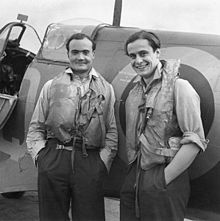
His Boss told him that he had been posted to a Training School and he had to go immediately. At first he hated the place and the pupils but slowly came to accept them at RAF Debden. He was promoted to Flight Commander. The Battle of Britain was over but “It was a damn near run thing”. He flew on, training new Hurricane pilots. His close friend was shot down over the Channel—so many friends lost. Eventually he found a new peace and flew as much as possible and he was awarded the Distinguished Flying Cross. He carried out many fighter sweeps and bomber escorts over France, often twice a day. The RAF met up with a new German fighter, the FW190 which was faster than a Spitfire. In a dogfight over France he recalls fighting harder than ever, fear growing to anger and resignation, breathing and groaning hard, “If I’m killed, then I’m killed”. Suddenly he found himself all alone over Dunkirk. “Where has everybody gone”? He had had a number of splitting headaches and felt completely knackered. He was given 48 hours Stand Down with no flying.
Suddenly, he was posted overseas via an Aircraft Carrier named HMS Furious, which after calling at Gibraltar sets off in the company of over 30 ships on Operation Pedestal going to Malta. Most of the Merchant Ships were sunk on the way as well as HMS Eagle, another Aircraft Carrier. Geoff’s Spitfires could not take off from HMS Furious because their propellors did not give them enough ‘lift’. The propellors were changed for new ones and Geoff led his planes on to Malta where he met up with the tanker, SS Ohio, limping into Valetta supported by 2 British Destroyers (see SS Ohio Story).
So, the fuel and the Spitfires arrived in Malta to relieve the Island and also to help defeat Rommel in North Africa. Geoff’s headaches become much worse and the RAF Doctor forbade him to fly on operations and sent him back to Britain. Liquid pressure will have to be removed from behind his eyes. He needed a prolonged rest from operational flying and was sent home to his parents to recuperate.
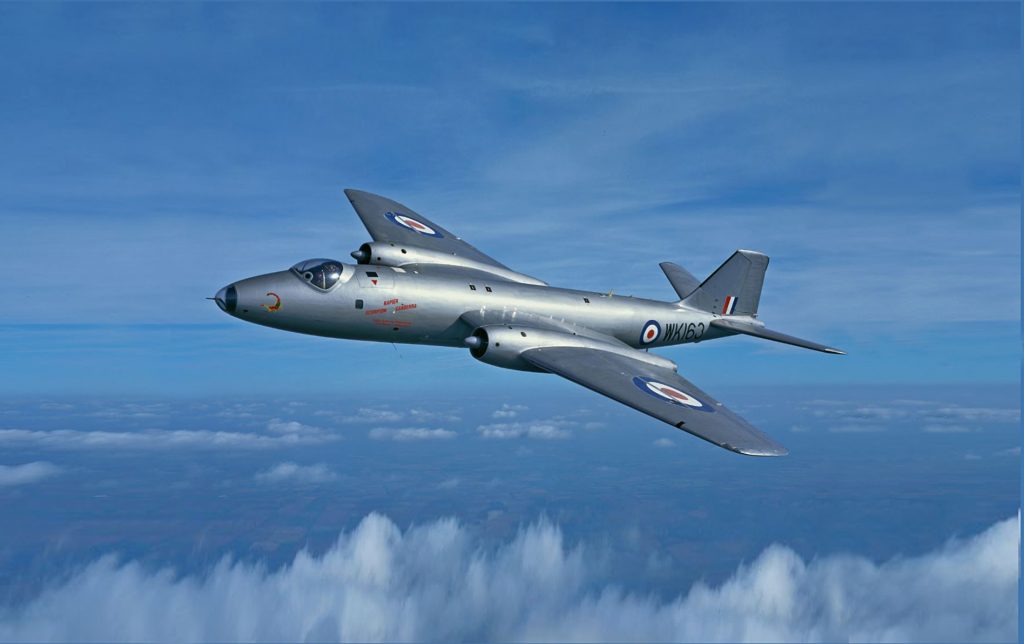
Geoff grieved for all his lost friends and cursed that he had reached the pinnacle of his life before the age of 22. He had gone “over the top” and had been destroyed by the War at an early age. He began a new career as an RAF Test Pilot on Jet Aircraft such as the Meteor, Vampire and Canberra. Later he became an RAF Staff Officer until he retired in 1960. He died in 2018 having given his whole life to the RAF as he had intended.
